What To Use To Clean Leather Car Seats effectively involves selecting the right cleaning agents and tools to maintain their luxurious condition. At CARS.EDU.VN, we provide a comprehensive guide to help you choose the best cleaning solutions and methods to keep your leather car seats looking their best. Discover expert tips and product recommendations for leather care, ensuring your car’s interior remains pristine with proper leather maintenance and detailing techniques.
1. Understanding Leather Car Seat Cleaning
Leather car seats offer a touch of luxury, but they require special care to maintain their appearance and prevent damage. Regular cleaning is essential to remove dirt, grime, and spills that can accumulate over time. Understanding the types of leather used in car seats and the appropriate cleaning methods is the first step in maintaining their beauty.
1.1. Types of Leather Used in Car Seats
Various types of leather are used in car seats, each with its unique characteristics:
- Aniline Leather: This is the most natural-looking leather, as it retains the hide’s original surface. It’s also the most delicate and requires gentle cleaning.
- Semi-Aniline Leather: This leather has a light surface coating for added protection against stains and wear. It’s more durable than aniline leather but still requires careful cleaning.
- Protected Leather (also known as Coated or Pigmented Leather): This is the most common type of leather used in car seats. It has a polymer surface coating that makes it highly resistant to stains and fading. While more durable, it still benefits from regular cleaning.
- Nappa Leather: Known for its softness and smooth texture, nappa leather is a premium option that requires gentle care to prevent damage.
1.2. Why Regular Cleaning is Important
Regular cleaning of leather car seats is crucial for several reasons:
- Preventing Stains: Dirt, spills, and body oils can penetrate the leather and cause stubborn stains. Regular cleaning removes these contaminants before they become permanent.
- Maintaining Suppleness: Leather can dry out and crack over time if not properly maintained. Cleaning followed by conditioning keeps the leather supple and prevents cracking.
- Preserving Appearance: Regular cleaning helps maintain the leather’s original color and luster, keeping your car’s interior looking new.
- Hygiene: Cleaning removes bacteria and allergens that can accumulate on the seats, promoting a healthier environment inside your car.
CARS.EDU.VN Tip: Regular cleaning not only preserves the aesthetic appeal of your leather seats but also contributes to a more comfortable and hygienic driving experience. Stay informed with the best cleaning practices to ensure your car’s interior remains in top condition.
2. Essential Supplies for Cleaning Leather Car Seats
Before you begin cleaning your leather car seats, gather the necessary supplies. Using the right tools and products will ensure effective cleaning without damaging the leather.
2.1. Cleaning Solutions
Choosing the right cleaning solution is crucial for safely and effectively cleaning leather car seats. Here are some options to consider:
- Leather-Specific Cleaners: These are formulated specifically for leather and are pH-balanced to prevent damage. Brands like Lexol, Leather Honey, and Chemical Guys offer excellent leather cleaners.
- Mild Soap and Water: A solution of mild dish soap and water can be effective for light cleaning. Use a small amount of soap and ensure the cloth is only damp, not wet.
- DIY Solutions: A mixture of vinegar and water (1 part vinegar to 5 parts water) can be used for cleaning. Always test in an inconspicuous area first to ensure it doesn’t cause discoloration.
2.2. Cleaning Tools
Using the right tools will help you clean your leather seats effectively and safely:
- Microfiber Towels: These are soft, absorbent, and won’t scratch the leather. Use one for applying the cleaning solution and another for wiping away dirt and residue.
- Soft-Bristled Brush: A soft-bristled brush, like a horsehair brush, can help loosen dirt and grime from the leather’s surface.
- Vacuum Cleaner: Use a vacuum cleaner with a brush attachment to remove loose dirt and debris from the seats before cleaning.
- Spray Bottle: A spray bottle is useful for applying the cleaning solution evenly.
- Foam Applicator Pads: These can be used to apply leather conditioner for even coverage.
CARS.EDU.VN Insight: Selecting the appropriate cleaning solutions and tools is essential for maintaining the quality of your leather car seats. Explore detailed product reviews and expert recommendations on CARS.EDU.VN to make informed choices.
3. Step-by-Step Guide to Cleaning Leather Car Seats
Follow these steps to clean your leather car seats effectively and safely. Regular cleaning every two to three months will keep your seats looking their best.
3.1. Preparation
- Vacuum the Seats: Use a vacuum cleaner with a brush attachment to remove loose dirt, crumbs, and debris from the seats and crevices.
- Test the Cleaning Solution: Before applying the cleaning solution to the entire seat, test it in an inconspicuous area, such as under the seat or in a corner, to ensure it doesn’t cause discoloration or damage.
- Gather Your Supplies: Ensure you have all the necessary supplies within reach, including cleaning solution, microfiber towels, a soft-bristled brush, and a spray bottle.
3.2. Cleaning Process
- Apply the Cleaning Solution: Lightly spray the cleaning solution onto a microfiber towel. Avoid spraying directly onto the leather seats, as this can cause oversaturation.
- Wipe the Seats: Gently wipe the leather seats with the damp microfiber towel, using a circular motion. Focus on one section at a time to ensure thorough cleaning.
- Use a Soft-Bristled Brush: For stubborn dirt or stains, lightly scrub the area with a soft-bristled brush. Avoid applying too much pressure, as this can damage the leather.
- Wipe Away Residue: Use a clean, damp microfiber towel to wipe away any remaining cleaning solution and dirt.
- Dry the Seats: Use a dry microfiber towel to thoroughly dry the leather seats. Avoid leaving the seats wet, as this can lead to water spots or mildew.
3.3. Conditioning the Leather
After cleaning, it’s essential to condition the leather to keep it supple and prevent cracking:
- Apply Leather Conditioner: Apply a small amount of leather conditioner to a foam applicator pad or microfiber towel.
- Work the Conditioner into the Leather: Gently massage the conditioner into the leather, using a circular motion. Ensure even coverage, paying attention to areas that are prone to drying out, such as the seat bolsters and headrests.
- Allow the Conditioner to Absorb: Let the conditioner absorb into the leather for the time specified on the product label, typically 10-20 minutes.
- Wipe Away Excess Conditioner: Use a clean microfiber towel to wipe away any excess conditioner. The leather should feel soft and supple, not greasy.
CARS.EDU.VN Recommendation: Regularly conditioning your leather seats is as important as cleaning them. CARS.EDU.VN offers detailed guides on selecting and applying the best leather conditioners to keep your seats in excellent condition.
3.4. Dealing with Specific Stains
Certain types of stains require specific cleaning methods:
- Ink Stains: Dab the stain with rubbing alcohol on a cotton swab, then blot with a clean cloth. Follow with leather cleaner and conditioner.
- Grease Stains: Sprinkle baking soda on the stain and let it sit for several hours to absorb the grease. Vacuum up the baking soda and clean the area with leather cleaner.
- Water Stains: Lightly dampen the entire seat with distilled water, then blot with a clean cloth. This helps to even out the appearance and prevent water spots. Follow with leather conditioner.
Safety Tip: Always test any cleaning solution or stain remover in an inconspicuous area before applying it to the entire seat. This will help prevent damage or discoloration.
4. Best Products for Cleaning and Conditioning Leather Car Seats
Choosing the right products can make a significant difference in the effectiveness of your leather cleaning routine. Here are some highly recommended products available on the market:
4.1. Leather Cleaners
| Product | Features | Pros | Cons |
|---|---|---|---|
| Lexol Leather Cleaner | pH-balanced formula, gentle and effective | Safe for all types of leather, removes dirt and grime without drying | May require multiple applications for heavy stains |
| Leather Honey Leather Cleaner | Concentrated formula, non-toxic, and water-repellent | Excellent for restoring old and worn leather, effective stain removal | Requires dilution, may leave a slight residue if not properly wiped |
| Chemical Guys Leather Cleaner | Sprayable, pH-balanced, contains conditioners | Cleans and conditions in one step, preserves leather strength and appearance | Some users may find the scent strong |
| Griot’s Garage Leather Cleaner | Gentle formula, safe for all leather surfaces | Effectively removes dirt and grime, leaves leather feeling soft and supple | Not as effective on heavy stains |
| Meguiar’s Gold Class Leather & Vinyl Cleaner | Versatile formula, can be used on leather and vinyl surfaces | Cleans and protects, convenient for maintaining multiple surfaces in your car | Not specifically designed for heavily soiled leather |

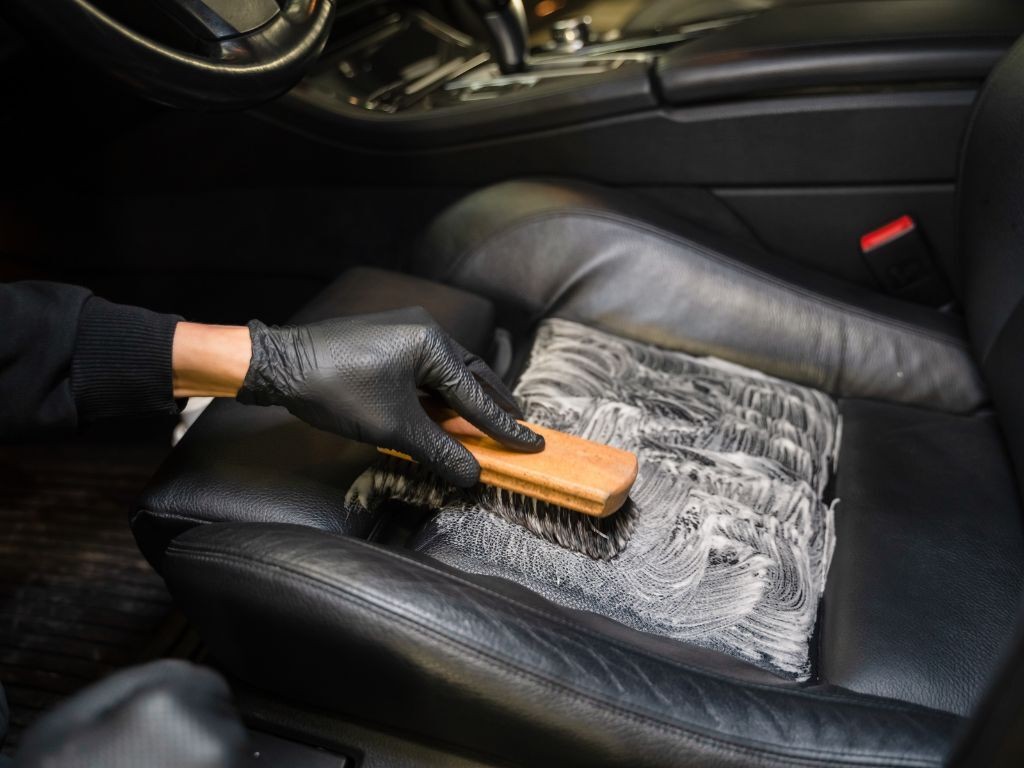
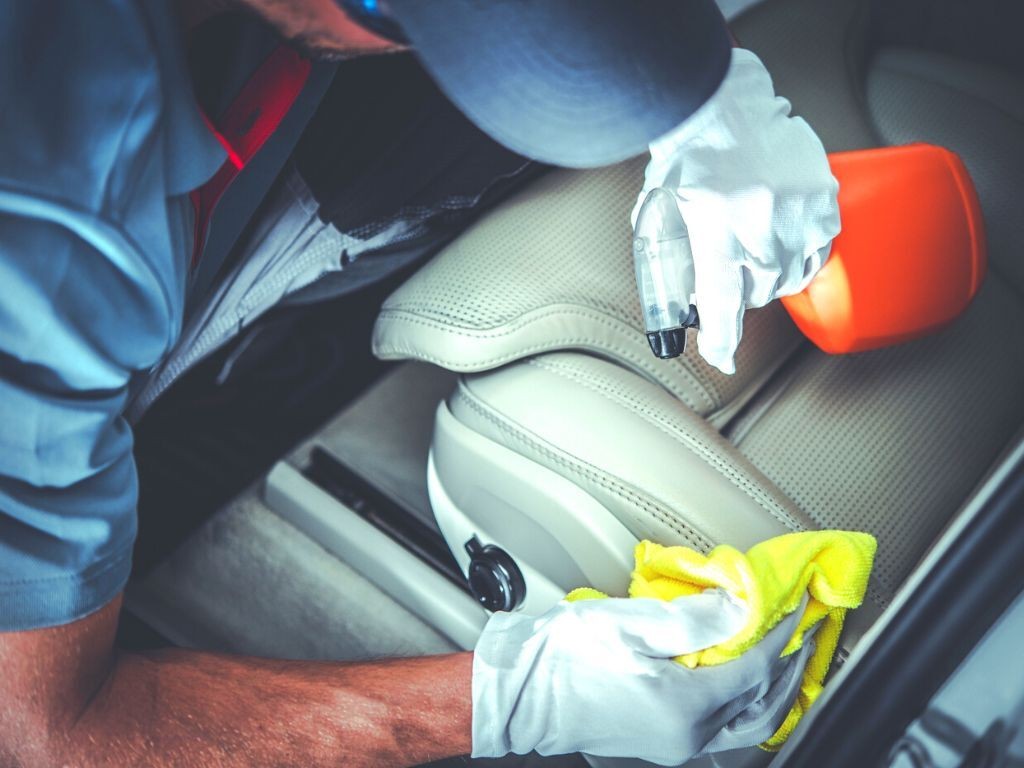
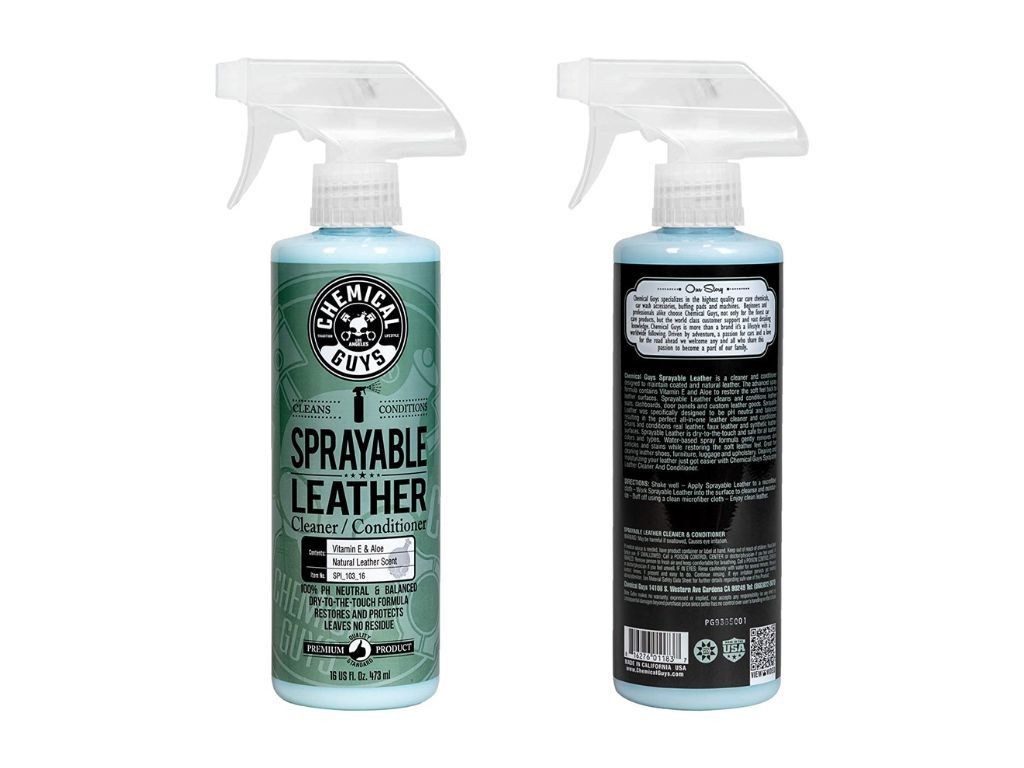
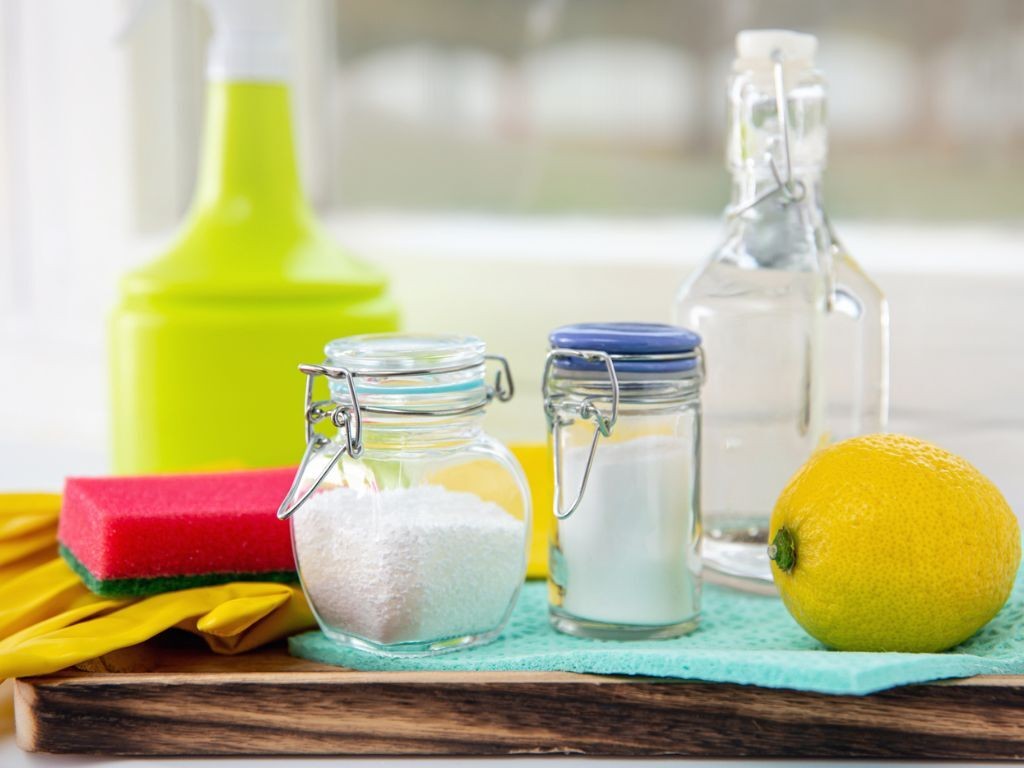
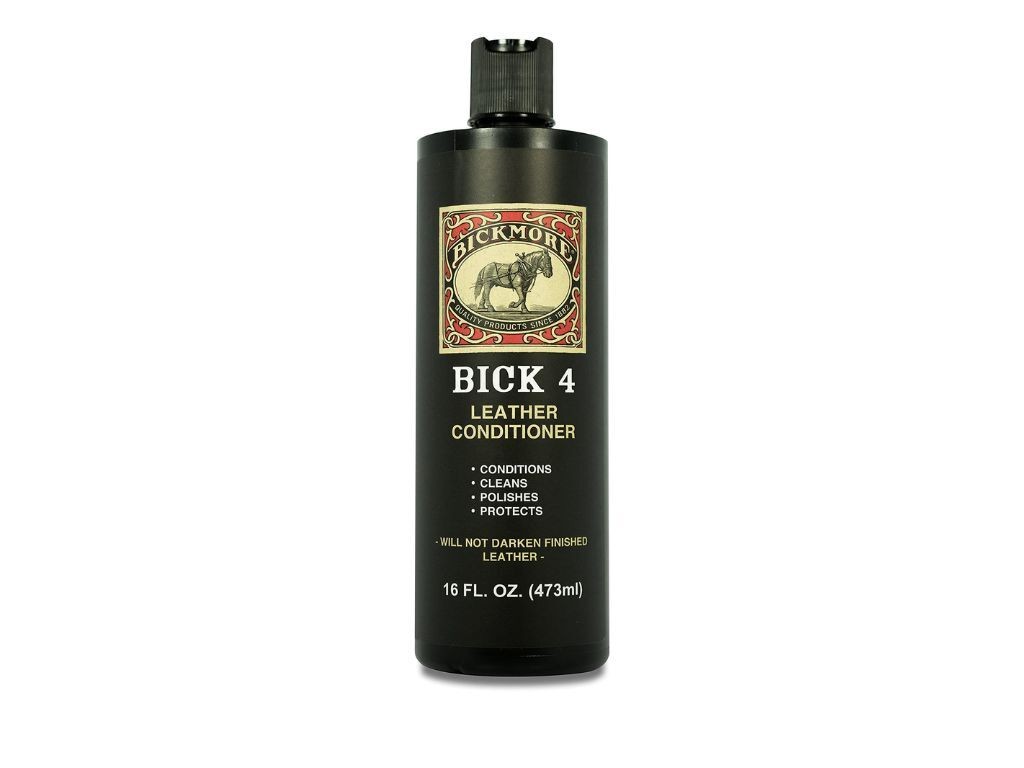
4.2. Leather Conditioners
| Product | Features | Pros | Cons |
|---|---|---|---|
| Lexol Leather Conditioner | Non-greasy formula, contains UV protectants | Protects against cracking and fading, keeps leather soft and supple | May require multiple applications for very dry leather |
| Leather Honey Leather Conditioner | Highly concentrated, non-toxic, water-repellent | Excellent for restoring old leather, provides long-lasting protection | Requires thorough application to avoid residue |
| Chemical Guys Leather Conditioner | Contains vitamin E, protects against UV damage | Nourishes and protects leather, leaves a pleasant scent | Some users may find the scent overpowering |
| Meguiar’s Gold Class Leather Conditioner | Contains aloe and moisturizing oils, provides UV protection | Maintains original leather appearance, prevents aging and fading | May not be as effective on heavily damaged leather |
| Bickmore Bick 4 Leather Conditioner | Wax-free formula, doesn’t darken leather | Ideal for preserving the original color of your leather seats, prevents leather pores from sealing | May not provide as much protection as conditioners with wax |
CARS.EDU.VN Product Spotlight: Visit CARS.EDU.VN for in-depth reviews and comparisons of the best leather cleaning and conditioning products. Our experts provide unbiased recommendations to help you choose the right products for your car.
5. DIY Leather Cleaning Solutions
If you prefer a more natural approach, several DIY leather cleaning solutions can be effective. These options use common household ingredients and are generally safe for leather, but always test in an inconspicuous area first.
5.1. Vinegar and Water
- Ingredients: 1 part white vinegar, 5 parts distilled water
- Method: Mix the vinegar and water in a spray bottle. Lightly spray the solution onto a microfiber towel and wipe the leather seats. Follow with a clean, damp cloth to remove any residue, and dry thoroughly.
5.2. Mild Soap and Water
- Ingredients: A few drops of mild dish soap, 1 gallon of warm distilled water
- Method: Mix the soap and water in a bucket. Dip a microfiber towel into the solution, wring out excess water, and wipe the leather seats. Follow with a clean, damp cloth to remove any residue, and dry thoroughly.
5.3. Olive Oil
- Ingredients: A small amount of olive oil
- Method: Apply a small amount of olive oil to a microfiber towel and gently rub it into the leather seats. Let it sit for 30 minutes, then wipe away any excess oil with a clean cloth. Olive oil can help condition and soften the leather.
5.4. Baking Soda Paste
- Ingredients: Baking soda, distilled water
- Method: Make a paste of baking soda and water. Apply the paste to the stain and let it sit for a few hours. Wipe away the paste with a clean, damp cloth.
5.5. Coconut Oil
- Ingredients: Coconut oil
- Method: Apply a small amount of coconut oil to a microfiber towel and gently rub it into the leather seats. Let it sit for 30 minutes, then wipe away any excess oil with a clean cloth. Coconut oil works as a natural leather conditioner and can help restore its smooth appearance.
DIY Caution: While DIY solutions can be effective, they may not be suitable for all types of leather. Always test in an inconspicuous area first and avoid using harsh chemicals or abrasive cleaners.
6. Maintaining Leather Car Seats: Tips and Best Practices
Regular maintenance is key to keeping your leather car seats in top condition. Here are some tips and best practices to follow:
6.1. Regular Cleaning Schedule
- Frequency: Clean your leather car seats every 2-3 months to prevent dirt and grime from building up.
- Quick Wipe-Downs: Perform quick wipe-downs with a damp microfiber towel weekly to remove loose dirt and spills.
6.2. Protection from Sunlight
- Parking: Park your car in the shade whenever possible to protect the leather from direct sunlight, which can cause fading and cracking.
- Window Tinting: Consider getting your car windows tinted to reduce the amount of UV radiation that enters the car.
- Sunshades: Use sunshades on the windshield and rear window when parking in direct sunlight.
6.3. Avoid Harsh Chemicals
- Cleaning Products: Avoid using harsh chemicals, such as bleach, ammonia, or abrasive cleaners, as they can damage the leather.
- DIY Solutions: Be cautious when using DIY cleaning solutions, and always test in an inconspicuous area first.
6.4. Prompt Spill Cleanup
- Act Quickly: Clean up spills as soon as they occur to prevent staining.
- Blot, Don’t Rub: Blot the spill with a clean cloth, working from the outside in to prevent spreading.
- Follow Up with Leather Cleaner: After blotting the spill, clean the area with a leather cleaner and conditioner.
6.5. Professional Detailing
- Consider Professional Services: Consider hiring a professional detailing service for thorough cleaning and conditioning, especially for heavily soiled or damaged leather.
- Experienced Technicians: Ensure the detailing service has experienced technicians who are familiar with leather care.
CARS.EDU.VN Maintenance Guide: CARS.EDU.VN provides comprehensive maintenance guides and schedules to help you keep your car in optimal condition. Visit our website for expert advice on all aspects of car care.
7. Common Mistakes to Avoid When Cleaning Leather Car Seats
Avoiding common mistakes can prevent damage to your leather car seats and ensure effective cleaning.
7.1. Using Too Much Water
- Avoid Oversaturation: Avoid saturating the leather with water, as this can cause water spots and damage. Use a damp cloth, not a wet one.
- Dry Thoroughly: Always dry the seats thoroughly after cleaning to prevent water damage.
7.2. Using Abrasive Cleaners
- Gentle Products Only: Only use gentle, pH-balanced cleaning products that are specifically designed for leather.
- Avoid Scrubbing: Avoid using abrasive cleaners or scrubbing too hard, as this can scratch or damage the leather.
7.3. Neglecting to Condition
- Condition After Cleaning: Always condition the leather after cleaning to replenish its natural oils and prevent drying and cracking.
- Regular Conditioning: Make conditioning a regular part of your leather care routine, not just an occasional task.
7.4. Ignoring Stains
- Prompt Action: Address stains as soon as they occur to prevent them from becoming permanent.
- Proper Stain Removal: Use the appropriate stain removal techniques for each type of stain.
7.5. Failing to Test Products
- Inconspicuous Area: Always test any cleaning product or DIY solution in an inconspicuous area before applying it to the entire seat.
- Observe for Damage: Observe the area for any signs of discoloration, damage, or adverse reactions before proceeding.
CARS.EDU.VN Safety Tips: CARS.EDU.VN emphasizes safety in all aspects of car care. Follow our safety tips and guidelines to protect your car and yourself during the cleaning and maintenance process.
8. Advanced Leather Care Techniques
For more advanced leather care, consider these techniques to restore and protect your leather car seats.
8.1. Leather Repair Kits
- Minor Damage: Use a leather repair kit to fix minor scratches, cracks, and tears.
- Color Matching: Choose a kit that includes color-matching compounds to blend the repair seamlessly with the surrounding leather.
8.2. Leather Dyeing
- Faded or Discolored Leather: Dye faded or discolored leather to restore its original color.
- Professional Dyeing: Consider hiring a professional for best results, as dyeing can be a complex process.
8.3. Leather Refinishing
- Heavily Damaged Leather: Refinish heavily damaged leather to restore its appearance and durability.
- Professional Refinishing: This process involves stripping the old finish, repairing any damage, and applying a new finish.
8.4. Using Leatherique Products
- Rejuvenating Oil and Prestine Clean: Leatherique offers a two-step process using Rejuvenating Oil and Prestine Clean to deep clean and restore leather.
- Deep Cleaning: Rejuvenating Oil penetrates the leather to dissolve dirt and oils, while Prestine Clean removes the contaminants from the surface.
8.5. Steam Cleaning
- Deep Cleaning: Steam cleaning can be used to deep clean leather and remove stubborn dirt and grime.
- Caution: Use a low-pressure steamer and avoid prolonged exposure to prevent damage.
CARS.EDU.VN Expert Advice: CARS.EDU.VN connects you with automotive experts who can provide personalized advice and recommendations for advanced leather care techniques. Contact us today for assistance.
9. Comparing Professional Detailing vs. DIY Cleaning
Deciding between professional detailing and DIY cleaning depends on your budget, time, and the condition of your leather car seats.
9.1. Professional Detailing
- Pros:
- Thorough cleaning and conditioning
- Professional-grade products and equipment
- Expertise in handling different types of leather
- Convenience and time-saving
- Cons:
- Higher cost
- Requires scheduling an appointment
9.2. DIY Cleaning
- Pros:
- Lower cost
- Convenience and flexibility
- Control over the cleaning process
- Cons:
- Requires time and effort
- May not be as effective as professional detailing
- Risk of damaging the leather if not done properly
9.3. When to Choose Professional Detailing
- Heavily Soiled Leather: When the leather is heavily soiled or stained.
- Damaged Leather: When the leather has significant damage, such as cracks or tears.
- Limited Time: When you have limited time or prefer to avoid the hassle of DIY cleaning.
- Specialized Needs: When you need specialized services, such as leather repair or dyeing.
9.4. When to Choose DIY Cleaning
- Regular Maintenance: For regular cleaning and maintenance of well-maintained leather.
- Budget Constraints: When you are on a budget and prefer to save money.
- Enjoy Car Care: When you enjoy taking care of your car and have the time and patience to do it properly.
CARS.EDU.VN Service Directory: CARS.EDU.VN provides a directory of reputable professional detailing services in your area. Browse our listings and find the best service to meet your needs.
10. Reader Engagement and Call to Action
10.1. Share Your Experience
- Reader Interaction: Share your experiences and tips for cleaning leather car seats in the comments section.
- Community Building: Join the CARS.EDU.VN community and connect with other car enthusiasts.
10.2. Ask the Experts
- Expert Q&A: Submit your questions about leather care to our experts for personalized advice.
- Knowledge Sharing: Benefit from the collective knowledge and experience of our community.
10.3. Explore CARS.EDU.VN
- Comprehensive Resources: Explore CARS.EDU.VN for more articles, guides, and resources on car care, maintenance, and repair.
- Stay Informed: Stay informed with the latest trends and innovations in the automotive industry.
10.4. Find Local Services
- Service Directory: Use the CARS.EDU.VN service directory to find reputable car care professionals in your area.
- Quality Assurance: Ensure your car receives the best possible care from trusted providers.
10.5. Call to Action
- Visit CARS.EDU.VN: For more detailed information, expert advice, and service recommendations, visit cars.edu.vn today.
- Contact Us: If you have any questions or need assistance, contact us at 456 Auto Drive, Anytown, CA 90210, United States, or call us at Whatsapp: +1 555-123-4567.
Maintaining leather car seats requires a consistent cleaning routine and the right products. Whether you choose professional detailing or DIY cleaning, the key is to use gentle, pH-balanced cleaners, condition the leather regularly, and protect it from sunlight and harsh chemicals. With proper care, your leather car seats will remain luxurious and comfortable for years to come.
FAQs About Cleaning Leather Car Seats
1. How often should I clean my leather car seats?
It’s recommended to clean your leather car seats every 2-3 months to prevent dirt and grime buildup. However, if you frequently spill or notice dirt, clean them more often.
2. Can I use regular household cleaners on leather car seats?
No, avoid using regular household cleaners like bleach, ammonia, or dish soap, as they can damage the leather. Use pH-balanced leather-specific cleaners or mild DIY solutions.
3. What is the best way to remove ink stains from leather car seats?
Dab the ink stain with rubbing alcohol on a cotton swab, then blot with a clean cloth. Follow with a leather cleaner and conditioner.
4. How can I prevent my leather car seats from cracking?
Regularly condition the leather to keep it supple and prevent drying. Protect the seats from direct sunlight by parking in the shade and using sunshades.
5. Can I use a steam cleaner on leather car seats?
Yes, you can use a low-pressure steamer to deep clean leather seats. However, avoid prolonged exposure and keep the steamer moving to prevent damage.
6. What is the best DIY solution for cleaning leather car seats?
A solution of 1 part white vinegar and 5 parts distilled water can be effective for light cleaning. Always test in an inconspicuous area first.
7. Should I condition my leather car seats after cleaning?
Yes, always condition the leather after cleaning to replenish its natural oils and prevent drying and cracking.
8. What type of microfiber towel should I use for cleaning leather car seats?
Use a soft, lint-free microfiber towel to avoid scratching the leather.
9. How do I remove grease stains from leather car seats?
Sprinkle baking soda on the grease stain and let it sit for several hours to absorb the grease. Vacuum up the baking soda and clean the area with leather cleaner.
10. Is professional detailing worth it for cleaning leather car seats?
Professional detailing can be worth it for heavily soiled or damaged leather, as it provides a thorough cleaning and conditioning with professional-grade products and equipment.